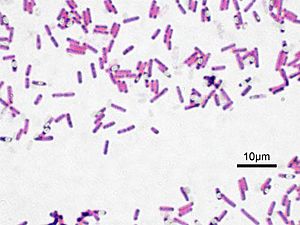Bacillota facts for kids
Quick facts for kids Bacillota |
|
|---|---|
 |
|
| Bacillus subtilis, Gram-stained | |
| Scientific classification |
|
| Domain: | Bacteria |
| (unranked): | Terrabacteria |
| Phylum: | Firmicutes Gibbons and Murray 2021 |
| Classes | |
|
|
| Synonyms | |
|
|
The Bacillota (also known as Firmicutes) are a group of tiny living things called bacteria. Most of them have a special outer layer, called a cell wall, that stains purple when scientists do a test called a Gram-stain. This is why they are called 'gram-positive'.
The name 'Firmicutes' means 'tough skin' in Latin. This refers to the thick cell wall that these bacteria usually have. Scientists once thought all gram-positive bacteria belonged to this group. Now, they know Bacillota are a specific core group.
These bacteria can be shaped like tiny balls, called cocci (singular: coccus), or like small rods, called bacilli. Some Bacillota, like Megasphaera, Pectinatus, Selenomonas, and Zymophilus, have a different kind of outer layer. This makes them stain red or pink in the Gram-stain test, so they are called gram-negative.
Many Bacillota can create special, tough structures called endospores. These spores are very strong and can survive in harsh conditions, like when it's very dry. You can find Bacillota in many different places. Some types can cause diseases, while others are important for making things like beer and wine go bad.
Contents
Main Types of Bacillota
Scientists usually divide Bacillota into two main groups, or classes:
- The Clostridia are bacteria that live without air. They are called anaerobic.
- The Bacilli are bacteria that need air to live, or can live with or without it. They are called aerobes.
Important Bacillota Genera
There are more than 274 different groups (genera) of Bacillota. Here are some well-known ones:
Bacilli Class
- Order Bacillales
- Bacillus: Some types are used in medicine or can cause food poisoning.
- Listeria: Can cause serious foodborne illness.
- Staphylococcus: Includes bacteria that can cause skin infections.
- Order Lactobacillales
- Enterococcus: Found in the gut, some can cause infections.
- Lactobacillus: Often found in yogurt and fermented foods, good for digestion.
- Leuconostoc: Used in making fermented foods like sauerkraut.
- Streptococcus: Includes bacteria that can cause strep throat.
Clostridia Class
- Clostridioides: A type that can cause severe gut infections.
- Clostridium: Includes bacteria that cause tetanus and botulism.
- Selenomonas: Found in the mouth and gut.
Erysipelotrichia Class
- Erysipelothrix: Can cause skin infections in animals and humans.
Bacillota and Your Health
Bacillota are a big part of the tiny living community inside your gut, called the gut microbiome. In humans, they make up about 30% of the gut bacteria.
Scientists are studying how Bacillota in the gut might affect how our bodies use energy. They are also looking into possible links between these bacteria and conditions like diabetes and how our bodies store fat.
One very common Bacillota bacterium in a healthy adult gut is Faecalibacterium prausnitzii. This type makes up about 5% of all gut bacteria. It is linked to less inflammation in the body, which is a good thing.
Studies have shown that people who are overweight sometimes have more Bacillota in their gut than people who are not. For example, higher levels of Lactobacillus, a type of Bacillota, have been found in people who are overweight. When these people went on diets to lose weight, the amount of Bacillota in their gut often went down.
Research with mice has also shown interesting connections. Mice that ate a diet high in fat and sugar had more Bacillota in their gut. These mice also gained more weight. When gut bacteria from overweight mice (with more Bacillota) were put into mice that had no gut bacteria, those mice gained a lot of fat.
Another type of Bacillota, Christensenella, has been linked to a healthier body mass index. This means people with more of this bacterium tend to have a healthier weight.
See also
 In Spanish: Bacillota para niños
In Spanish: Bacillota para niños
- List of bacteria genera
- List of bacterial orders

